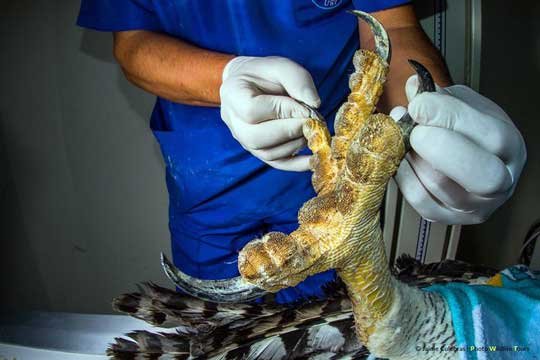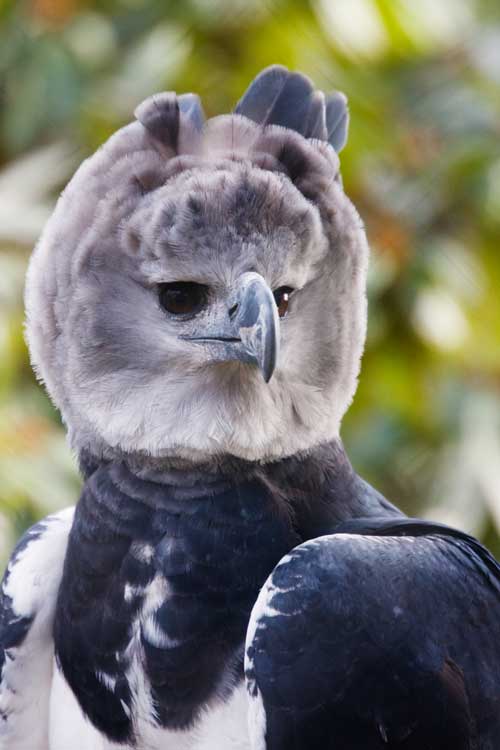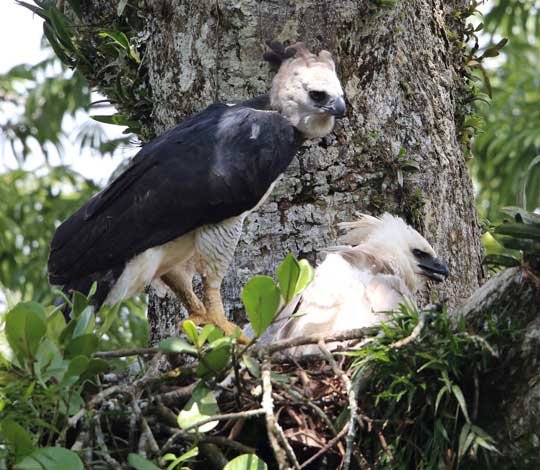|
All eagles are, in general, pretty cool birds, but the harpy eagle takes coolness to a whole new level. It's the largest raptor in the Americas, and it hunts monkeys, sloths, porcupines, macaws, and iguanas. It has five-inch talons (longer than a grizzly bear's claws). Not only that, but it can puff up its head feathers to look like the king (or queen) of all birds. What the heck is a Harpy Eagle? The harpy eagle (Harpia harpyja) is one of the largest, most powerful eagles in the world, and it lives and hunts in the canopy portion of tropical rainforests. Although the bird is rare, its range extends through Central America into much of South America, particularly Brazil. Unfortunately, except for Panama, it is almost extinct in Central America. Harpy eagles were first described back in 1758, and they were named after the beasts of Greek mythology called harpies (fictional creatures with the body of a vulture and the face of a woman). the harpy eagle is most closely related to the crested eagle and the New Guinea harpy eagle. Amazing Facts about the Harpy Eagle First we need to talk about the hunting power of these birds. Harpy eagles have wing spans of about 6 feet (1.8 m), which is not particularly long for an eagle of this size (the smaller bald eagle can have a wing span of 7.5 feet). Why the shorter wings? Because most eagles hunt in open areas, where they can soar while they search for prey. Harpy eagles hunt in dense rainforest, where they need to be highly maneuverable. Their wings are short and very broad, which helps with maneuverability. Harpy eagles are apex predators, at the top of their food chain, which means they have no predators to fear (other than humans). Occasionally they are attacked by jaguars or ocelots, but this is thought to be rare. These birds don't mess around with small prey. Apparently they like the challenge of hunting larger animals. Although they feed on a variety of tree-dwelling animals, harpy eagles seem to prefer mammals, especially monkeys and sloths. Sloths can make up over half of their diet. Harpies ignore the smaller monkeys (like marmosets) and instead go for howler monkeys, capuchin monkeys, saki monkeys, titi monkeys, squirrel monkeys, and spider monkeys. If a harpy eagle can't find a sloth or a monkey, it will happily kill and eat a porcupine, squirrel, opossum, anteater, armadillo, kinkajou, or coati. Although they prefer mammals, these eagles will eat large parrots like macaws, iguanas and other large lizards, and snakes. Rarely, they even sometimes kill domestic chickens, lambs, goats, and pigs. One study showed that harpy eagles killed 102 different prey species! Here is a harpy eagle that has just caught a monkey. Harpy eagles are powerful birds. As I said above, they like hunting large prey, and the larger females have never been recorded taking a prey animal weighing less than 6 pounds (2.7 kg). They are often seen snatching and flying off with mature howler monkeys and sloths weighing up to 20 pounds (9.1 kg), which is equal to or heavier than the eagle itself. Typically, these eagles are perch hunters. They fly from tree to tree then sit for a while to listen and look for movement. When they spot a prey animal, they swoop in and pluck it from the trees, or sometimes from the ground. Harpy eagles have larger talons than any other living eagles, usually 3-4 inches (7.6-10.1 cm) long, and sometimes up to 5 inches (12.7 cm) long, longer than the claws of a grizzly bear. Harpy eagles have powerful clutching toes, and they typically use their long claws to kill their prey. Their beaks are powerful enough to easily crack mammal bones but are used mostly for feeding rather than killing. Check out the impressive harpy eagle foot and talons below. The harpy eagle is one of the few raptors (other than some owls) that has a facial disc. The harpy can puff out the feathers around its face to form a concave disc with its face in the center. Why? Because, like owls, these birds rely on sound to help them find their prey (the forest is rather dark under the thick rainforest canopy). The facial disc helps to funnel sound to their ears. When they puff up their feathers to do this, they often end up with some long feathers sticking up from the back of their head, making them look rather majestic. Check out this video about harpy eagles hunting. Harpy eagles breed only once every two to three years. They are monogamous, and a pair will make a massive nest out of sticks. Even after the young hatch, the adults continuously add sticks that have green vegetation attached. This is thought to help keep the interior of the nest cool. They typically lay two eggs, and the female incubates them for about 55 days. Surprisingly, when the first egg hatches, that young is nurtured, but the other egg is ignored, and the chick inside will die. Why? This allows the two parents to put all their energy into raising one healthy eaglet. You might wonder why they don't just lay one egg in the first place. By laying two, there is more likelihood that at least one will develop normally and hatch. Two more tidbits of interesting information. The harpy eagle was used for inspiration for the design on the mythical creature Fawkes the Phoenix in the Harry Potter movies (as well as in the second Fantastic Beasts movie). Also, the harpy eagle is the national bird of Panama and is featured on the official Panama coat of arms. So, the Harpy Eagle deserves a place in the I.A.H.O.F. (Inimitable Animal Hall of Fame). FUN FACT: The word inimitable originated way back in about 1525. It comes from the Latin word inimitabilis, which literally means "that cannot be imitated." The prefix in- means "the opposite of," and "imitabilis" means "imitable." So, anything that is inimitable cannot be imitated. The word is often confused with inimical, which means "harmful or hostile" (as in "a climate inimical to health"). However, if you can keep the two words straight, inimitable is a good way to express how unique (and often amazing) something or someone is, as in "Genesis Sequence is another of Stan Smith's inimitable novels." So, inimitable is another way to say awesome! Trish just told me she doesn't like either of the words, inimitable or inimical, because they are too hard to pronounce! Photo Credits:
Harpy eagle #1, with head feathers up - DepositPhotos Harpy eagle carrying monkey - Jiang Chunsheng, CC BY 4.0, via Wikimedia Commons Harpy eagle foot - Carnivora Harpy eagle face with head feathers up - "Harpy Eagle" by mirsasha is licensed under CC BY-NC-ND 2.0 Harpy eagle on nest with eaglet - DepositPhotos Coat of Arms of Panama - Milenioscuro and Gumff, Public domain, via Wikimedia Commons
0 Comments
Leave a Reply. |
Stan's Cogitations
Everyone needs a creative outlet. That's why I write. Archives
July 2024
|







 RSS Feed
RSS Feed